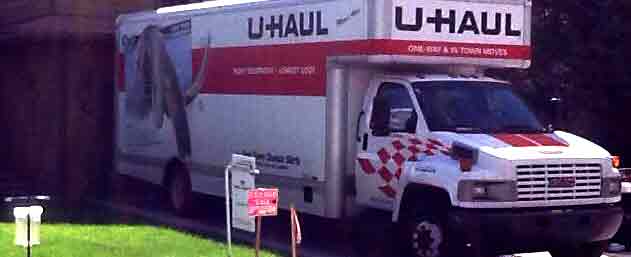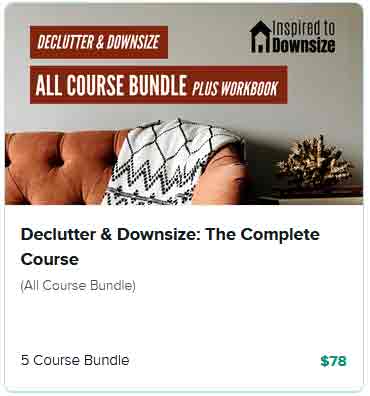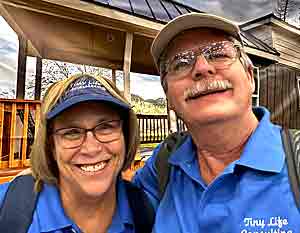Downsizing, A Journey
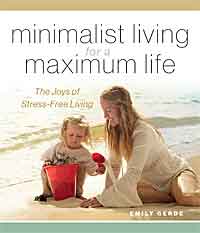
The downsizing process will be different for everyone. Folks downsize for a number of reasons: financial and/or family considerations, retirement, the desire to simplify their lives, to leave a smaller carbon imprint upon the planet, or any number of reasons for making the change.
In 2018, my wife Rachel and I retired, sold the house we’d been using for home and business, and moved three hundred miles to the southwest corner of Colorado. Without the income we’d been able to pull in during our working years, we had to dramatically downsize. We were hoping to be closer to our kids and grandkids. But we’d lived in the same valley for forty-five years, so a lot of changes were in store.
Here we’ll share the lessons learned from our journey, with the updates from five years down the road. Hopefully our experience, along with tips from other people who have taken the journey, will give you a glimpse into what this might look like for you.
Determine How Small You Can Go
One of our first stops was a house for sale about ninety miles away. At 960 sq./ft, it seemed very small compared to the 2734 sq./ft. house we were living in. True, we weren’t going to running a couple of businesses out of there, but when we considered what life would really look like, we decided it was too small for us.
We had watched numerous tiny house and house-buying shows on TV. This helped us understand each others preferences. As much as we loved watching Hawaii Life, our budget allowed for only a space under a picnic table on Waikiki. We’ve lived in the Colorado Rockies for decades and knew we wanted to stay there, but after revisiting town after town, many were ruled out. Too windy, too cold, too expensive. Finally, we settled on a town that, although farther away than we would have liked, was closer to our family, within our price range, and offered most of amenities a vintage couple such as ourselves would need. It looked great on paper, and it was, but we had a lot to learn.
Rachel’s suggestions for moving to an unfamiliar location
“When we decided which town we were moving to, I started reading their weekly newspaper online. That helped me get a feel for the people, the resources, their community spirit, etc. What I wish I had done: Find their Facebook community pages. Reading the residents’ questions, insights, joys, sorrows, questions, and problems would have been incredibly helpful.
What we did: found a realtor to work with. What I wish I had done: obtained a map of the town and the surrounding area, and had the realtor explain the different neighborhoods, homeowners associations, pros and cons, access to services, etc. The realtor showed us properties within our price range, but she didn’t tell us which neighborhoods had good cell service, adequate internet service, crime, etc.
I would find out as much as possible about the area before looking for a house or property there. I would still have moved here, but forewarned is forearmed.”
We made a list of wants and needs
Back to Kevin:
We wanted our house to be stick built with normal utilities, like water and sewer. I didn’t really want a townhouse, condo, or apartment, and I wanted to have a workshop. She was fine with that as long as we had high-speed internet, good cell phone reception, and no stairs. We needed a grocery store, a few restaurants, and medical care nearby, and all within our budget. So, without having actually defined the actual structure or swinging a hammer, our new home was taking shape within our minds.
Downsizing is easy to say, but much harder to do. In anticipation of retirement I’d been attempting to downsize for a long time. Sorting through the crawlspace, I found several things that sold on eBay. We had bi-annual garage sales that help us get rid of even more. Still, every closet was packed with stuff. Then there was the garage, not to mention the tool shed. The crawlspace, for all of my efforts, was still packed.
Decluttering
So began the serious phase of downsizing. In our new town, we found a two-bedroom, two-bathroom house with a single-car garage, 1100 sq/ft, so we were losing 1634 sq /ft plus half of the garage space. This was as small as we felt we could possibly go, given that our kids and grandkids would be coming from out of town to visit. At the same time, we were preparing our old house to sell, and we quickly became acquainted with the decluttering process. This meant renting a storage unit and moving as many things as we could out of the house. I thought Rachel had made a mistake when she rented the biggest storage unit they had, but we nearly filled it up. It was interesting to see what we had to retrieve as the weeks went by.
One of the things I missed the most (as silly as this may seem) was my back scratcher. I found out that I use it almost every day. I hadn’t even noticed that I did. So, the lesson, don’t give up the things you use everyday.
Declutter & Downsize: The Complete Course
The idea of living with less stuff may sound great, but the reality of downsizing and getting rid of things can be overwhelming and even emotional.
If you are the sentimental type (like me!) who hangs on to things “just in case” or because of the memories they represent, this course will help you work up gradually to dealing with more difficult items after you first gain some momentum and taste the freedom that letting go can bring.
On the other hand, maybe you are eager to be rid of your excess clutter but just don’t know where to begin with the task. This course is for you, too, as it offers practical, actionable steps to help you get the ball rolling.
Click on the image to see complete details. You can order it in separate segments if you’d rather.
The course includes:
- A printable workbook to help guide you through the process
- A printable calendar for planning your downsize
- A list with links to over a hundred organizations for donating and recycling specific items
Here is a list of Ashley Mann’s videos by title:
- Closet Cleanout and Wardrobe Planning Bundle
- DeClutter And Downsize Your Closet: 21 Day Challenge
- Jump Start To Downsizing
- Practical Tips For Downsizing
- Declutter And Downsize Household Items
- Declutter And Downsize Your Kitchen
- Declutter And Downsize Your Closet
- Declutter and Downsize Sentimental Belongings
Ashley Mann is a gifted blogger. She has an awesome blog RV Inspiration. Ashley and her husband downsized into a 38′ fifth wheel. She has tons of helpful tips and how-to videos.
The Kitchen
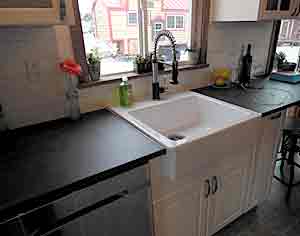
In the weeks between listing our big house and our actual closing, we paid attention to what we had to retrieve from the storage unit. The Crock Pot slow cooker came back home. It is an essential kitchen appliance like the coffee maker and toaster. But we didn’t retrieve several cutting boards (two seem to be enough) and several large boxes of other things. Ultimately, Rachel let go of a lot, which was difficult. She loves to entertain, but there would be no room for extra serving dishes, glassware, vases, storage containers, flatware, utensils, etc. Off they went to various new homes.
Dishes: The good set and the everyday set of dishes
You only need one set of dishes. It made sense to keep the good ones and dump the old ones. We learned (the hard way) that, before you do, test to see if the good dishes are microwavable. Ours were not. Who knew? We should have kept the everyday dishes. In any case, trim down the dishes and flatware. We probably had twenty-five mugs, many of which had been gifts. We got it down to ten.
Coffee cups and glasses
One “downsizer” recommended keeping just one coffee mug and one water glass because she reasoned, “How many mouths do you have?” But actually, if you use a dishwasher, it’s more about how often you will be running your dishwasher. If you don’t mind washing your one dish and one glass by had after each use, one will do. But if you only run your dishwasher every other day, you might need a few more of each.
Clothing
- I went through my closet and drawers and made the easy decisions first. All of the jeans with holes that I was saving as Saturday clothing, all the pants that no long fit, shoes I haven’t worn in years, gone. Clothing fell into four categories:
- Keeping: Hawaiian shirts are my new uniform.
- Selling: My wife sold a lot of clothes at consignment stores. Most of my clothes gets worn out before I stop wearing them.
- Donating: We were able to donate ski suits and sports clothes we are unable to use anymore.
- Dumping: “Just let it go dear,” my wife said, rolling her eyes. “No one is going to buy your old crap.”
As time went on, we discarded more and more. This may have been easier for us, because we were no longer working, and therefore didn’t need business attire.
Doing laundry in a smaller house
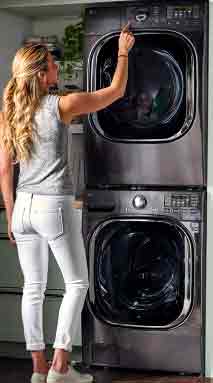
The washer and dryer are tucked into a hallway alcove and they’re working great. We have a full-size front load washer and dryer that work a lot better than the old appliances we left behind. Without a laundry room, we fold clothes on the bed and iron in the kitchen. We’ve found that every space in our new house has more than one use. Here is more on laundry in a tiny home.
Knickknacks & Keepsakes
Tchotchkes. The baubles that have value, if only to you. They are what gives your home its unique character. I had a really nice collection of shells, corals, and other island trinkets in a six foot tall, lighted display case. It was in a corner of our home for years. I was hoping there be a place for it in the new house. Rethinking what you want your habitat to reflect is a very personal issue that needs careful consideration.
Sadly, the display case went to Habitat for Humanity, and my island trinkets reside in our very non-tropical crawlspace.
We did not know we had a lot of Christmas decorations. It didn’t seem like a lot in a big house. But in the small house we don’t even have room for a tree (let alone the three we had). After selling the artificial trees via a local Facebook®, online yard sale page, we made a “wall tree.” It’s a bit of a pain to put up, but the grandkids still think it’s magical so we do, too.
Video Media Like VHS tapes, DVD’s, and Photo Albums
A friend is currently cleaning out her house and found VHS tapes of her kids when they were young. She also found a DVD of Casablanca, and more.
I know it hurts, but you can’t even sell those “collectors items” on eBay. Why? Because all of them, except for your personal photographs and home movies, are available through digital streaming services and in much better quality.
I had every episode of every series of Star Trek on VHS. That was a sad, sad day when I dumped those in the trash. I did, however, keep my DVD player and certain “select” DVDs just in case the internet is down and I really need to watch Star Trek.
If you are planning on living off-grid or in an area where Internet access is limited, you might consider keeping some DVDs. However, these can be downloaded onto your computer, phone, Pad, or thumb-drive, and have a much smaller footprint.
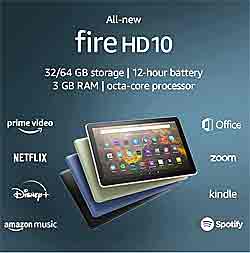
Send your home movies and photos to be digitized at iMemories.
Downsizing Your Books
We order our books from Amazon in the Kindle version and they’re automatically loading onto our Kindle Fire. With “Kindle Unlimited” many of the books are no additional charge. Our Kindle also has apps for streaming Netflix®, Prime Video®, and YouTube®.
Furniture
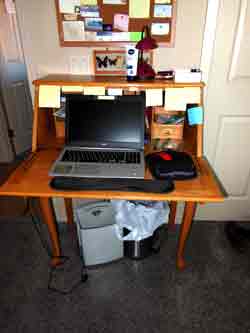 My wife took a picture of each piece of furniture we had. She measured them and made a scale drawing of the house we are moving to. Then she fit each piece into the floor plan to see what we could keep and what we would need to get rid of. She listed many items on Craig’s list and in the local classifieds. Thankfully, the new house had one wall in living room for my 65″ TV and surround sound system.
My wife took a picture of each piece of furniture we had. She measured them and made a scale drawing of the house we are moving to. Then she fit each piece into the floor plan to see what we could keep and what we would need to get rid of. She listed many items on Craig’s list and in the local classifieds. Thankfully, the new house had one wall in living room for my 65″ TV and surround sound system.
The way it worked out
Most of the furniture from the old house never made it to the new house. My recliner survived the transition, and strangely, the secretary desk that was just a “catch-all” in the kitchen became an essential piece of her office (see photo).
We sold our beds and dressers, and bought beds with drawers underneath. We left our dining room table for our old home’s new owners and bought a table and three chairs, using a bench from the old house for the fourth side. We sold our sofa and loveseat and bought a sofa/trundle for seating, ottoman, and extra sleeping area.
We combined our office equipment and downsized to a shared multi-function printer.
Ditch the floor lamps
We brought the floor lamps just because they were in our house. Eventually, however, we slowly sold them off to gain the floor space. We installed on-wall lighting instead. See more about tiny house lighting here.
A Small House Fits Together Like A Puzzle
Every inch of a tiny house needs to fit like a puzzle piece into every other part of the tiny house. It may take time and living in the new situation to get the right puzzle pieces to fit. I’ve listed some unique furniture perfect for tiny spaces on this page.
The garage
Most of the things I have retrieved from the storage unit have been garage items. As a “tool user” it is essential for me to have on hand the tools and hardware items necessary to make quick repairs, or projects without a trip to the hardware store. I also need a place to store the lawnmower, snowblower, shovels, rakes, sprinklers, hoses, etc. Our new house has a garage, but it would be nice to actually get a car inside it. A shed might be needed for storage as well.
Toys and Miscellaneous Stuff
Most of us own toys. Whether it be a kayak, bike, ATV, or just a fishing pole. We will need someplace to keep our toys. I have seen shipping containers re-purposed into storage sheds. Because of their metal construction they are very secure, but very heavy. In our case, the fishing poles found their new home in a corner of the garage. Fortunately, our well-lit and lined crawlspace runs the entire length of the house for all the other miscellanea like suitcases, wrapping paper, holiday supplies, etc.
So, this is the journey we have taken thus far to determine the comfort level of downsizing for us. Ooo, the dog. Gotta have room for the dog.
Backstock
“Let the store be your storage.” I don’t know who coined that phrase but it applies. No more COSTCO runs. In the years we were working and raising kids, we took advantage of big-box store sales to save money. Now we still try to use the supermarket sales, but we have to limit how much we bring home. We sold the deep freezer so I can’t horde twenty packages of bacon like I used to. Like everything else in tiny living, it’s a trade-off.
Update on our downsizing experience
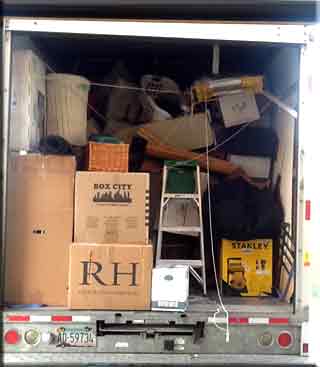
The largest U-Haul truck “packed to the gills” was not enough space.
We sold most of the furniture and BBQ grill with the house. Habitat for Humanity picked up a few things but they are really picky. We had to pay the trash guys to haul away some of the furnishings.
We had four yard sales and took twelve truck loads to the dump before packing everything else into the biggest truck U-Haul has and then had to rent a cargo van for the overflow! The U-Haul blew a gasket trying to haul all of our stuff over the mountains to our new home.
After unpacking we had two more yard sales, two trips to the second-hand store, and a load of towels to the animal shelter. Sadly, my shell collection sits in a box in the crawlspace, and I sold my surround system through a local online yard sale site and replaced it with a Sonos PLAYBAR TV Soundbar /Music Speaker.
The Upside
For the first time since we were kids, we are living within our means. Our small house is one-story, so we can do almost all the maintenance ourselves. Our yard is so small that I sold my self-propelled gas lawnmower and bought a tiny electric mower. It’s like the Easy-Bake Oven™ of yard equipment. It’s light, easy to use, and it only takes me twenty minutes to do the front and back. When we’re expecting company, it takes a couple of hours to clean the entire house, top to bottom, instead of a couple of days. While we don’t have money for extravagance, we have everything we need. Occasionally we miss one or two things from our old ‘stuff,’ but we don’t miss the bigger bills that came with the bigger house. We are grateful.
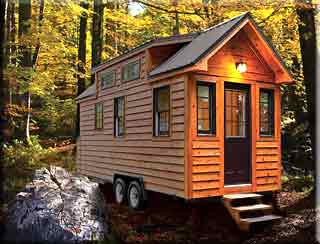
This is the most popular design from “Tiny Home Builders.” You can order the unit in three sizes already built or just the plans.
Retiring Tiny
People retiring, who have already taken some of the steps in downsizing, might be ready for a Tiny House or an Auxiliary Dwelling Unit (ADU).
Tiny Home Builders builds several models of tiny homes. If you are able to build your own, they also sell just the plans.
Imagine pulling your tiny house into your son’s or daughter’s backyard. Many cities and counties allow this. A contractor connects your tiny home to the main house utilities and you roll out the welcome mat.
When it comes to putting down roots in your offspring’s backyard, ADUs cover an extensive range of options, including adaptations for medical concerns. They can also be more acceptable in some situations with state, county, and local code and zoning laws, as well as homeowners associations regulations.


